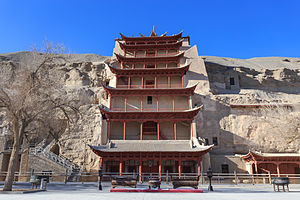Mogao Caves
The Mogao Caves, also known as the Thousand Buddha Grottoes or Caves of the Thousand Buddhas, form a system of 492 temples 25 km (16 mi) southeast of the center of Dunhuang, an oasis strategically located at a religious and cultural crossroads on the Silk Road, in Gansu province, China. The caves may also be known as the Dunhuang Caves, however, this term is also used as a collective term to include other Buddhist cave sites in and around the Dunhuang area.
An important cache of documents was discovered in 1900 in the so-called "Library Cave", which had been walled-up in the 11th century. The contents of the library were subsequently dispersed around the world, and the largest collections are now found in Beijing, London, Paris and Berlin, and the International Dunhuang Project exists to coordinate and collect scholarly work on the Dunhuang manuscripts and other material.
The caves themselves are now a popular tourist destination, with a number open for visiting.[1]
The caves contain some of the finest examples of Buddhist art spanning a period of 1,000 years.[2] The first caves were dug out in 366 AD as places of Buddhist meditation and worship.[2][3]
The Mogao Caves are the best known of the Chinese Buddhist grottoes and, along with the Longmen Grottoes and Yungang Grottoes, are one of the three famous ancient Buddhist sculptural sites of China.
See also
References
- ↑ Makinen, Julie (September 27, 2014) "Getty Institute helps save China's Mogao Grottoes from tourism's impact" Los Angeles Times
- ↑ 2.0 2.1 "Mogao Caves". UNESCO. Retrieved 2007-08-05.
- ↑ Zhang Wengin
External links
| This article includes content from Mogao Caves on Wikipedia (view authors). License under CC BY-SA 3.0. |
